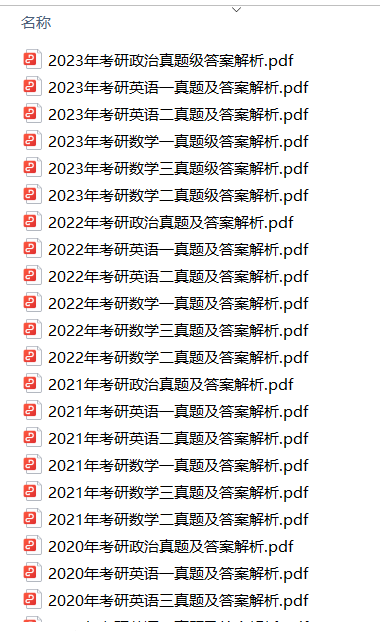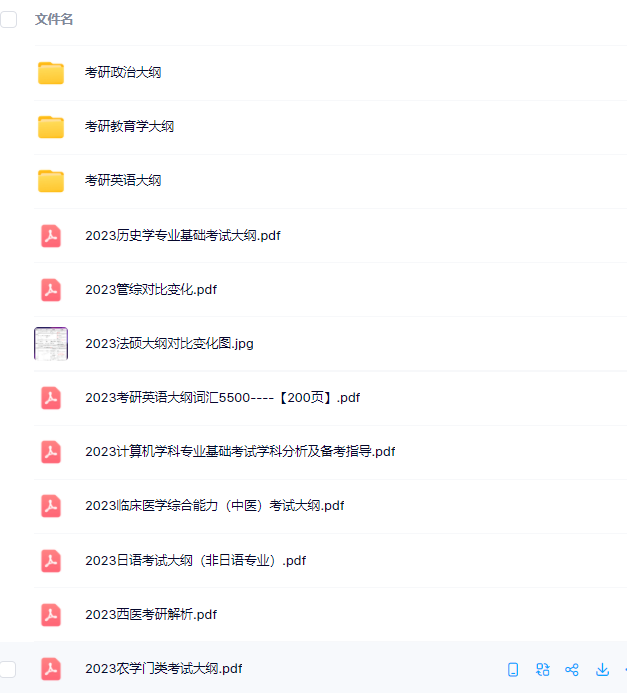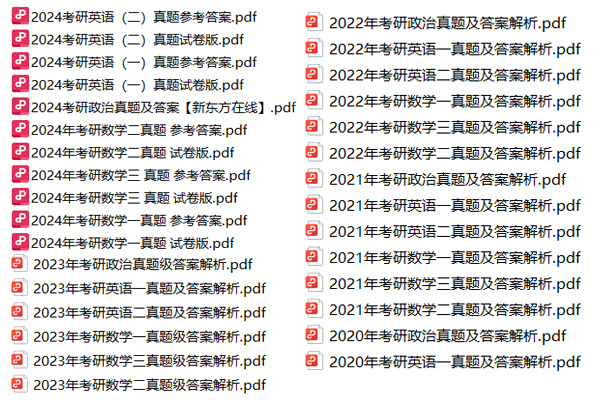特惠-26考研冲刺
特惠-27考研课
双证-在职硕士
免联考-同等学力
复试分数线
26复试全面指导
模拟复试面试
26考研-全套真题
26考研估分
保研-路线图
27考研-智能择校
27考研-英语测评
27考研-新大纲对比
热门-计算机择校

扫码加入训练营
牢记核心词
学习得礼盒
2023考研考试结束后,同学们在考后最关心的就是对答案了。新东方老师第一时间为大家整理了考研真题及答案解析。查看完整版考研真题解析及答案同学们:
点击下图,获得一手考研答案,听大咖解析真题,快来对答案!!
↓↓↓↓↓↓
2023年考研英语二应用文原文及范文
2023英语二试题及答案
Use of English
Here’s a common scenario that any number of entreprenuers face today:you’re the CEO of a small business and though you're making a nice 1, you need to find a way to take it to the next level. what you need to do is 2 growth by establishing a growth team. A growth team is made up of members from different departments within your company, and it harnesses the power of collaboration to focus 3 on finding ways to grow.
Let's look at a real-world 4. Prior to forming a growth team, the software company BitTorrent had 50 employees. Working in the 5 departments of engineering, marketing and product development. This brought them good results until 2012, when their growth plateaued. The 6 was that too many customers were using the basic, free version of their product. And 7 improvements to the premium, paid version, few people were making the upgrade.
Things changed,8, when an innovative project marketing manager came aboard,9 a growth team and sparked the kind of 10 perspective they needed. By looking at engineering issues from a marketing point of view, it became clear that the 11 of upgrades wasn't due to a quality issue. Most customers were simply unaware of the premium version and what it offered.
Armed with this 12, the marketing and engineering teams joined forces to raise awareness by prominently 13 the premium version to users of the free version. 14, upgrades skyrocketed, and revenue increased by 92 percent.
But in order for your growth, team to succeed, it needs to a have a strong leader. It needs someone who can 15 the interdisciplinary team and keep them on course for improvement.
This leader will 16_ the target area, set clear goals and establish a time frame for the 17of these goals. This growth leader is also 18 for keeping the team focus on moving forward and steer them clear of distractons.19 attractive, new ideas can be distracting, the team leader must recognize when these ideas don’t 20 the current goal and need to de put on the back burner.
1.A.purchase B. profit C. connection D. bet
2.A. define B. predict C. prioritize D. appreciate
3. A. exclusively B. temporarily C. potentially D. initially
4. A. experiment B. proposal C. debate D. example
5. A. identical B. marginal C. provisional D. traditional
6. A. rumor B. secret C. myth D. problem
7. A. despite B. unlike C. through D. besides
8. A. moreover B. however C. therefore D. again
9. A. inspected B. created C. expanded D. reformed
10. A. cultural B. objective C. fresh D. personal
11. A. end B. burden C. lack D. decrease
12. A. policy B. suggestion C. purpose D. insight
13. A. contributing B. allocating C. promoting D. transferring
14. A. As a result B. At any rate C. By the way D. In a sense
15. A. unite B. finance C. follow D. choose
16. A. share B. identify C. divide D. broaden
17. A. announcement B. assessment C. adjustment D. accomplishment
18. A. famous B. responsible C. available D. respectable
19. A. Before B. Once C. while D. Unless
20. A. serve B. limit C. summarize D. alter
Text 1
In the quest for the perfect lawns, homeowners across the country are taking a shortcut -- and it is the environment that is paying the price. About eight million square meters of plastic grass is sold each year but oppositions has now spread to the highest gardening circles. The Chelsen Flower Show has banned fake grass from this year’s event, declaiming it to be not part of its ethos. The Royal Horticultural Society (RHS), which norms the annual show in west London, says it has introduced the ban because of the damage plastic grass does to the environment and biodiversity.
Ed Horne of the RHS said: we launched our sustainability strategy last year and fake grass is just not in line with our ethos and views on plastic. We recommend using real grass because of its environment benefits, which include supporting wildlife, alleviating flooding and cooling the environment.
The RHS’s decision comes as compaginers try to raise awareness of the problem fake grass cause. A Twitter account, which claims to “cut through the greenwash” of artificial grass, already has more than 20,000 followers. It is trying to encourage people to sigh two petitions, one calling for a ban on the sale of plastic grass and another calling for an “ecological damage” tax on such lawns. They have gathered 7,276 and 11,282 signatures.
However, supporters of fake grass point out that there’s also an environmental impact with natural lawns, which need mowing and therefore usually consume electricity or petrol. The industry also points out that real grass require considerable amounts of water, weed killer or other treatments and that people who lay fake grass tend to use their garden more. The industry also claims that people who lay fake grass spend on average of £500 trees or shrouds for their garden, which provides habitat for insects.
21. The RHS thinks that plastic grass
A. is harmful to the environment.
B.is a hot topic in gardening circles C.is overpraised in the annual show
D.is ruining the view of west London
22. The petitions mentioned in Paragraph 3 reveal the campaigners'
A disappointment with the RHS.
B resistance to fake grass use.
C. anger over the proposed tax.
D. concern about real grass supply
23. In Paragroph 4.,supporters of fake grass point out
A.the necessity to lower the costs of fake grass
B. the disadvantage of growing real grass.
C.the way to take care of artificial lawns
D the challenges of insect habitat protection
24.what would the govenment do with regard to artifical grass ? A Urge legislation to restrict its use.
B Take measures to guarantee its quality
C Remind its users to obey existing rules
D. Replace it with sustainable alternatives
25 It can be learned from the text that fake grass
A. is being improved continously
B. has seen a market share docline.
C.is becoming increasingly affordabe
D has been a controversial product.
Text 2
It's easy to dismiss as absurd the federal government's ideas for plugging the chronic funding gap of our national parks. Can anyone really think it's a good idea to allow Amazon deliveries to your tent in Yosemite or food trucks to line up under the redwood trees at Sequoia National Park?
But the govemment is right about one thing: U.S. national parks are in crisis. Collectively, they have a maintenance backlog of more than $12 bllion. Roads, trails, restrooms, visitor centers and other infrastructure are crumbling.
But privatizing and commercializing the campgrounds would not be a crue-all. Campgrounds are a tiny portion of the overall infrastructure backlog, and businesses in the parks hand over, on average, only about 5% of their revenues to the National Park Service.
Moreover, increased privatization would certainly undercut one of the major reasons why 300 million visitors come to the parks each year: to enjoy nature and get a break from the commercial drumbeat that overwhelms daily life.
The real problem is that the parks have been chronically starved of funding. An economic survey of 700 U.S. taxpayers foundthat people would be willing to pay a significant amount of money to make sure the parks and their programs are kept intact. Some 81% ofrespondentsaid they would be willing to pay addítional taxes for the next 10 years to avoid anycuts to the national parks.
The natiopal parks provide greaf yaluejto U.S. residents both as places to escape and assymbols of nature. On top of this, they produce value from their extensive educational programs, their positive impact on the climate through carbon sequestration, their contribution to our cultural and artistic life, and of course through tourism. The parks also help keep America's past alive, working with thousands of local jurisdictions around the country to protect historical sites and to bring the stories of these places to life.
The parks do all this on a shoestring. Congress allocates only 3 bilion a year to the national park system — an amount that has been flat since 2001 ( in inflation-adusted dollars) with the exception of a onetime boost in 2009. Meanwhile, the number of annual visitors has increased more than 50% since 1980, and now stands at 330 million visitors per year.
26.What problem are US national parks faced with?
A. Decline of business profits
B. Inadequate commercialization
C. Lack of transportation services
D. Poorly maintained infrastructure
答案选D
27.Increased privatization of the campgrounds may___
A. spoil visitor experience
B. help preserve nature
C. bring operational pressure
D. boost visits to parks
答案选A
28.According to paragraph 5, most respondents in the survey would___.
A. go to national parks on a regular basis.
B. advocate a bigger budget for the national parks.
C. agree to pay extra for the national parks.
D. support the national parks’ recent reforms.
答案选C
29.The national parks are valuable in that they
A. lead the way in tourism
B. have historical significance
C. sponsor research on climate
D. provide an income for the locals.
答案B
30.It can be concluded from the text that the national park system_____
A. is able to cope with staff shortages
B. is able to meet visitors’ demands
C. is in need of a new pricing policy
D. is in need of a funding increase.
答案D
Text 3
The Internet may be changing merely what we remember, not our capacity to
do so, suggests Columbia University psychology professor Betsy Sparrow. In 2011, Sparrow led a study in which participants were asked to record 40 factoids in a computer ("an ostrich's eye is bigger than its brain," for example). Half of the participants were told the information would be erased, while the other half were told it would be saved. Guess what? The latter group made no effort to recall the information when quizzed on it later, because they knew they could find it on their computers. In the same study, a group was asked to remember both the information and the folders it was stored in. They didn't remember the information, but they remembered how to find the folders. In other words, human memory is not deteriorating but "adapting to new communications technology," Sparrow says.
In a very practical way, the Internet is becoming an external hard drive for our memories, a process known as "cognitive offloading." Traditionally, this role was fulfilled by data banks, libraries, and other humans. Your father may never remember birthdays because your mother does, for instance. Some worry that this is having a destructive effect on society but Sparrow sees an upside. Perhaps, she suggests, the trend will change our approach to learning from a focus on individual facts and memorization to an emphasis on more conceptual thinking - something that is not available on the Internet. “I personally have never seen all that much intellectual value in memorizing things," Sparrow says, adding that we haven't lost our ability to do it.
Still other experts say it's too soon to understand how the Internet affects our brains. There is no experimental evidence showing that it interferes with our ability to focus, for instance, wrote psychologists Christopher Chabris and Daniel J. Simons. And surfing the web exercised the brain more than reading did among computer-savvy older adults in a 2008 study involving 24 participants at the Semel Institute for Neuroscience and Human Behavior at the University of California, Los Angeles.
"There may be costs associated with our increased reliance on the Internet, but I'd have to imagine that overall the benefits are going to outweigh those costs," observes psychology professor Benjamin Storm. "It seems pretty clear that memory is changing, but is it changing for the better? At this point, we don't know."
31. Sparrow’s study shows that with the Internet, the human brain will
A. analyze information in detail
B. collect information efficiently
C. switch its focus of memory
D. extend its memory duration
32. The process of “cognitive offloading”
A. helps us identify false information
B. keeps our memory from failing
C. enables us to classify trivial facts
D. lessens our memory burdens
33. Which of the following would Sparrow support about the Internet?
A. It may reform our learning approach
B. It may impact our society negatively
C. It may enhance our adaptability to technology
D. It may interfere with our conceptual thinking
34. It is indicated in Para 3 that how the Internet affects our brains?
A. requires further academic research
B. is most studies in older adults
C. is reflected in our reading speed
D. depends on our web-surfing habits
35. Neither Sparrow nor Storm would agree that
A. our reliance on the Internet will be costly
B. the Internet is weakening our memory
C. memory exercise is a must for our brain
D. our ability to focus declines with age
Text 4
Teenagers are paradoxical. That’s a mild and detached way of saying something that parents often express with considerably stronger language. But the paradox is scientific as well as personal. In adolescence, helpless and dependent children who have relied on grown-ups for just about everything become independent people who can take care of themselves and help each other. At the same time, once cheerful and compliant children become rebellious teenage risk-takers.
A new study published in the journal Child Development by Eveline Crone of the University of Lerden and colleagues, suggests that the positive and negative sides of teenagers go hand in hard. The study is part of a new wave of thinking about adolescence. For a long time, scientists and policy markers concentrated on the idea that teenagers were a problem needed to be solved. The new work emphasizes that adolescence is a time of opportunity as well as risk.
The researchers studied "prosocial" and rebellious traits in more than 200 child and young adults, ranging from 11 to 28 years old. The participants filled out questions about how often they did things that were altruistic and positive, like sacrificing their own interests to help a friend or rebellious and negative, like getting drunk or staying out late.
Other studies have shown that rebellious behavior increased as you become a teenager and then fades away as you grow older. But the new study shows that, interestingly, the same pattern holds for prosocial behavior .Teenagers were more likely than younger children or adults to report that they did things like selfishly help a friend.
Most significantly ,there was a positive correlation between prosociality and rebelliousness. The teenagers who were more rebellious were also more likely to help others. The good and bad sides of adolescence seem to develop together.
Is there some common factor that underlies these apparently contradictory developments? One idea is that teenager behavior is related to what researchers call” reward sensitivity." Decision-making always involves balancing rewards and risks, benefits and costs “Reward sensitivity” 'measures how much reward it takes to outweigh risk .
Teenagers are particularly sensitive to social rewards-winning the game, impressing a new friend, getting that boy to notice you. Reward sensitivity, like prosocial behavior and risk-taking, seems to go up in adolescence and then down again as we age. Somehow, when you hit 30, the chance that something exciting and new will happen at that party just doesn’t seem to outweigh the effort of getting up off the conch.
36. According to Paragraph 1, children growing into adolescence tend to A
A. develop opposite personality traits
B. see the world in an unreasonable way
C. have fond memories of their past
D. show attention for their parents
37. It can be learned form Paragraph 2 that Crone’s study C
A. explores teenagers’ social responsibilities
B. examines teenagers’ emotional problems
C. provides a new insight into adolescence
D. highlights negative adolescent behavior
38. What does Crone’s study find about prosocial behavior D ?
A. It results from the wish to cooperate
B. It is cultivated through education
C. It is subject to family influence
D. It tends to peak in adolescence
39. It can be learned from the last two paragraph that teenagers B .
A. overstress their influence on others
B. care a lot about social recognition
C. become anxious about their future
D. endeavor to live a joyful life
40. what is the text mainly about? A
A. why teenagers are self-contradictory
B. why teenagers are risk-sensitive
C. How teenagers develop prosociality
D. How teenagers become independent
Part B
New building regulations aimed at improving energy efficiency are set to increase the price of new homes, as well as those of extensions and loft conversions on existing ones.
The rules, which came into effect on Wednesday in England, are part of government plans to reduce the UK’s carbon emissions to net zero by 2050. They set new standards for ventilation, energy efficiency and heating, and state that new residential buildings must have charging points for electric vehicles.
The moves are the most significant change to building regulations in years, and industry experts say they will inevitably lead to higher prices at a time when a shortage of materials and high labour costs is already driving up bills.
Brian Berry, chief executive of the Federation of Master Builders, a trade group for small and medium-sized builders, says the measures will require new materials, testing methods, products and systems to be installed. “All this comes at an increased cost during a time when prices are already sky high. Inevitably, consumers will have to pay more,” he says.
Gareth Belsham, of surveyors Naismiths, says people who are upgrading, or extending their home, will be directly affected.
“The biggest changes relate to heating and insulation,” he says. “There are new rules concerning the amount of glazing used in extensions, and any new windows or doors must be highly insulated.”
The changes could mean an extra £3,000 added to the bill of an average home extension, according to Jonathan Rolande of the National Association of Property Buyers, a group of professionals aimed at raising construction standards.
Homeowners extending may see the amount of space they have decrease, as walls will have to be thicker in order to comply with requirements for better insulation.
Andrew Mellor, of PRP architects, says external walls will need to be about 7cm thicker than previously.
Windows and doors will have to adhere to higher standards, while there are new limits on the amount of glazing you can have to reduce unwanted heat from the sun.
Thomas Goodman, of MyJobQuote, a site which sources quotes, says this will bring in new restrictions for extensions.
“Glazing on windows, doors and rooflights must cover no more than 25% of the floor area to prevent heat loss, ” he says.
As properties become more airtight, there are also measures to ensure proper airflow, such as having small openings (trickle vents) on windows that allow ventilation when a window is closed.
For people extending their homes, they may be required to install a new, or replacement, heating system depending on the size of the build, says Belsham. These will have to use lower temperature water to deliver the same heat, which will require increased insulation of pipes.
“We’ll see more insulation, better lighting design and restrictions on the amount of glass used in some areas. But with more thermal-efficient homes can come the risk of overheating due to solar gain, and so ventilation is also covered,” says Rolande. “As a result, double-glazed windows will require trickle vents to let heat escape and also to provide fresh air for health reasons and, of course, to reduce the risk of condensation build up in an ever-more airtight property.”
As the rules came into effect last Wednesday, property developers were rushing to file plans just before the deadline, according to Belsham. Any plans submitted before that date are considered to be under the previous rules, and can go ahead as long as work starts before 15 June next year.
Builders which have costed projects, but have not filed the paperwork, may need to go back and submit fresh estimates, says Marcus Jefford of Build Aviator, which prices projects.
As the changes are aimed to make homes more energy efficient, they will eventually drive down heating bills. But in the short-term homeowners are likely to face higher costs for work.
Materials prices are already up 25% in the last two years, according to figures from the Construction Products Association.
| 2023考研真题答案解析大汇总 | |||
| 公共课 | 政治 | 英语一 | 英语二 |
| 数学一 | 数学二 | 数学三 | |
| 公外日语 | |||
| 专业课 | 管理类联考 | 西医综合 | 教育学 |
| 法硕(法学) | 法硕(非法学) | 中医综合 | |
| 计算机 | 历史学 | 心理学 | |
| 金融 | 艺术 | ||
| 翻译硕士 | 汉语国际教育硕士 | 二外日语 | |
以上是新东方在线考研频道小编为大家带来的“2023年考研英语二应用文原文及范文”,希望考生们都能取得出色的成绩,顺利上岸。
【英语一二真题】资料这里有↑↑↑

 资料下载
资料下载
2014年-2025年考研历年真题汇总
发布时间:2024-04-25扫码添加【考研班主任】
即可领取资料包
考研大纲PDF电子版下载-历年(附解析)
发布时间:2024-04-25扫码添加【考研班主任】
即可领取资料包
2026年考研政数英备考资料zip压缩包
发布时间:2024-04-25扫码添加【考研班主任】
即可领取资料包
考研英语大纲词汇5500打印版(基础必备)
发布时间:2024-04-25扫码添加【考研班主任】
即可领取资料包
新东方在线考试模拟题【12套】
发布时间:2024-04-25扫码添加【考研班主任】
即可领取资料包
2026年考研专业课知识点总结
发布时间:2024-04-25扫码添加【考研班主任】
即可领取资料包
新东方考研资料下载地址
发布时间:2023-05-17新东方在线考研资料合集
下载方式:微信扫码,获取网盘链接

目录:
1.2013-2023年近10年政数英真题及解析PDF版(新东方)
2.2013-2023年专业课考试历年真题及解析PDF版
3.24考研复习备考资料大合集:大纲+备考资料+词汇书+考前押题+自命题
资料介绍:
1.2013-2023年近10年政数英真题及解析PDF版(新东方)
 、
、
2.2013-2023年专业课考试历年真题及解析PDF版


3.24考研复习备考资料大合集

3.24考研复习备考资料:考研大纲

3.24考研复习备考资料:政数英备考资料+自命题真题

------------------
考研备考过程中,尤其是专业课部分,参考往年的考试真题,对于我们的复习有更好的帮助。北京大学考研真题资料都有哪些?小编为大家进行了汇总。
北京大学考研真题资料-公共课

北京大学考研真题资料-专业课


以上就是关于“北京大学考研真题资料下载(历年汇总)”的整理,更多考研资料下载,请关注微信获取下载地址。
2024考研公共课必背知识点汇总
发布时间:2023-01-03扫码添加【考研班主任】
即可领取资料包
2013-2023考研历年真题汇总
发布时间:2023-01-03扫码添加【考研班主任】
即可领取资料包
考研英语大纲词汇(PDF可打印)
发布时间:2023-01-03扫码添加【考研班主任】
即可领取资料包
2024考研专业课知识点总结
发布时间:2023-01-03扫码添加【考研班主任】
即可领取资料包
2023考研政治 内部押题 PDF
发布时间:2022-11-16扫码添加【考研班主任】
即可领取资料包
徐涛:23考研预测六套卷
发布时间:2022-11-16扫码添加【考研班主任】
即可领取资料包
考研政数英冲刺资料最新整理
发布时间:2022-11-16扫码添加【考研班主任】
即可领取资料包
23考研答题卡模板打印版
发布时间:2022-11-16扫码添加【考研班主任】
即可领取资料包
2023考研大纲词汇5500PDF电子版
发布时间:2022-07-28扫码添加【考研班主任】
即可领取资料包
考研历年真题(公共课+专业课)
发布时间:2022-07-28扫码添加【考研班主任】
即可领取资料包
考研英语阅读100篇附解析及答案
发布时间:2022-01-07扫码添加【考研班主任】
即可领取资料包
新东方考研学霸笔记整理(打印版)
发布时间:2022-01-07扫码添加【考研班主任】
即可领取资料包
2001-2021年考研英语真题答案(可打印版)
发布时间:2022-01-07扫码添加【考研班主任】
即可领取资料包
考研英语词汇5500(完整版下载)
发布时间:2022-01-07扫码添加【考研班主任】
即可领取资料包
2022考研政审表模板精选10套
发布时间:2022-01-07扫码添加【考研班主任】
即可领取资料包
历年考研真题及答案 下载
发布时间:2021-12-09扫码添加【考研班主任】
即可领取资料包
考研政审表模板汇总
发布时间:2020-06-17扫码添加【考研班主任】
即可领取资料包
近5年考研英语真题汇总
发布时间:2020-06-17扫码添加【考研班主任】
即可领取资料包
考研英语大纲词汇5500
发布时间:2020-06-17扫码添加【考研班主任】
即可领取资料包
2022考研12大学科专业排名汇总
发布时间:2019-11-21扫码添加【考研班主任】
即可领取资料包
2023考研政治复习备考资料【珍藏版】
发布时间:2019-11-21扫码添加【考研班主任】
即可领取资料包
考研英语万能模板+必备词汇+范文
发布时间:2019-11-21扫码添加【考研班主任】
即可领取资料包
考研数学一、二、三历年真题整理
发布时间:2019-11-21扫码添加【考研班主任】
即可领取资料包

添加班主任领资料
添加考研班主任
免费领取考研历年真题等复习干货资料

 推荐阅读
推荐阅读
亲爱的26届考研同学们,对于备战考研英语二的考生来说,掌握有效的复习方法和高质量的备考资料至关重要。2025年考研英语二真题解析作为
来源 : 2025-03-20 08:37:00 关键字 : 考研英语二真题
亲爱的26届考研同学们,对于英语专业的考研生来说,英语专业考研一直是备考重点。通过有效的复习和高质量的学习资料才能确保成功。2025
来源 : 2025-03-19 08:34:00 关键字 : 英语专业考研真题
亲爱的26届考研同学们,考研英语一直是我们备考中的重要一环,高效的备考策略和优秀的学习资料是取得成功的关键。如今,学习资源的电子
来源 : 2025-03-18 08:32:00 关键字 : 英语考研真题电子版
亲爱的26届考研同学们,备战考研需要扎实的英语基础,尤其是翻译部分的备考更是对综合能力的一大挑战。2025年考研英语翻译真题作为最近
来源 : 2025-03-31 08:32:00 关键字 : 考研英语翻译真题
亲爱的26届考研同学们,考研英语作文作为英语考试中的重要组成部分,一直以来都是众多考生感到头疼的部分。如何精准地抓住考点,高效备
来源 : 网络 2025-03-31 08:29:00 关键字 : 2025年考研英语作文真题

 资料下载
资料下载
扫码添加【考研班主任】
即可领取资料包
扫码添加【考研班主任】
即可领取资料包
扫码添加【考研班主任】
即可领取资料包
扫码添加【考研班主任】
即可领取资料包
扫码添加【考研班主任】
即可领取资料包
扫码添加【考研班主任】
即可领取资料包
新东方在线考研资料合集
下载方式:微信扫码,获取网盘链接

目录:
1.2013-2023年近10年政数英真题及解析PDF版(新东方)
2.2013-2023年专业课考试历年真题及解析PDF版
3.24考研复习备考资料大合集:大纲+备考资料+词汇书+考前押题+自命题
资料介绍:
1.2013-2023年近10年政数英真题及解析PDF版(新东方)
 、
、
2.2013-2023年专业课考试历年真题及解析PDF版


3.24考研复习备考资料大合集

3.24考研复习备考资料:考研大纲

3.24考研复习备考资料:政数英备考资料+自命题真题

------------------
考研备考过程中,尤其是专业课部分,参考往年的考试真题,对于我们的复习有更好的帮助。北京大学考研真题资料都有哪些?小编为大家进行了汇总。
北京大学考研真题资料-公共课

北京大学考研真题资料-专业课


以上就是关于“北京大学考研真题资料下载(历年汇总)”的整理,更多考研资料下载,请关注微信获取下载地址。
扫码添加【考研班主任】
即可领取资料包
扫码添加【考研班主任】
即可领取资料包
扫码添加【考研班主任】
即可领取资料包
扫码添加【考研班主任】
即可领取资料包
扫码添加【考研班主任】
即可领取资料包
扫码添加【考研班主任】
即可领取资料包
扫码添加【考研班主任】
即可领取资料包
扫码添加【考研班主任】
即可领取资料包
扫码添加【考研班主任】
即可领取资料包
扫码添加【考研班主任】
即可领取资料包
扫码添加【考研班主任】
即可领取资料包
扫码添加【考研班主任】
即可领取资料包
扫码添加【考研班主任】
即可领取资料包
扫码添加【考研班主任】
即可领取资料包
扫码添加【考研班主任】
即可领取资料包
扫码添加【考研班主任】
即可领取资料包
扫码添加【考研班主任】
即可领取资料包
扫码添加【考研班主任】
即可领取资料包
扫码添加【考研班主任】
即可领取资料包
扫码添加【考研班主任】
即可领取资料包
扫码添加【考研班主任】
即可领取资料包
扫码添加【考研班主任】
即可领取资料包
扫码添加【考研班主任】
即可领取资料包

 阅读排行榜
阅读排行榜
 相关内容
相关内容